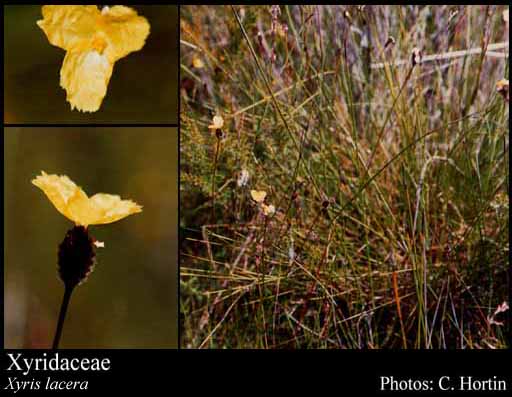- Reference
- Aphor.Bot. p158 (1823)
- Name Status
- Current

Scientific Description
Common name. Yellow-eyed Grass Family.
Habit and leaf form. Herbs. Perennial; plants with a basal concentration of leaves; rhizomatous. Helophytic, or mesophytic, or xerophytic. Leaves alternate; spiral, or distichous (mostly); ‘herbaceous’, or leathery; sessile; sheathing. Leaf sheaths with free margins. Leaves edgewise to the stem, or with ‘normal’ orientation; simple. Leaf blades entire; flat, or solid; linear; parallel-veined; without cross-venules. Leaves ligulate, or eligulate. Vegetative anatomy. Plants without silica bodies. Stem anatomy. Secondary thickening absent.
Reproductive type, pollination. Fertile flowers hermaphrodite. Unisexual flowers absent. Plants hermaphrodite. Floral nectaries absent (nectaries lacking). Entomophilous.
Inflorescence and flower features. Flowers aggregated in ‘inflorescences’; in spikes and in heads. The terminal inflorescence unit racemose. Inflorescences scapiflorous; usually a simple, headlike spike, rarely more than one spike; with involucral bracts, or without involucral bracts; pseudanthial, or not pseudanthial. Flowers bracteate; ebracteolate; small, or medium-sized; regular to very irregular; when irregular, zygomorphic. The floral asymmetry involving the perianth, or involving the perianth and involving the androecium. Flowers 3 merous; cyclic; tetracyclic, or pentacyclic. Perigone tube absent. Hypogynous disk absent. Perianth with distinct calyx and corolla (ostensibly), or of ‘tepals’; 6; 2 -whorled; isomerous, or anisomerous; free, or free and joined; having the outer and inner members sepaloid and petaloid (respectively); different in the two whorls. Calyx if the outer perianth be so interpreted, (2–)3 (the median member sometimes lacking — or caducous?); 1 -whorled; polysepalous, or partially gamosepalous. Sometimes having 2 of the members joined (the laterals, basally). Calyx unequal but not bilabiate; persistent. Corolla if the inner perianth be so interpreted, 3; 1 -whorled; polypetalous, or gamopetalous; imbricate; unequal but not bilabiate; yellow (usually), or white, or blue. Petals when free clawed, or sessile. Androecium 3, or 6. Androecial members adnate; free of one another; 1 -whorled, or 2 -whorled. Androecium exclusively of fertile stamens (the inner whorl), or including staminodes. Staminodes when present, 3 (the outer whorl); non-petaloid (sometimes plumose-branched). Stamens 3; isomerous with the perianth; oppositiperianthial. Anthers dehiscing via longitudinal slits; latrorse; tetrasporangiate. Pollen shed as single grains. Gynoecium 3 carpelled. The pistil 1 celled, or 3 celled. Carpels isomerous with the perianth. Gynoecium syncarpous; synstylovarious to eu-syncarpous; superior. Ovary unilocular, or plurilocular; 1 locular, or 3 locular (or incompletely trilocular). Gynoecium stylate. Styles 1 (three-branched); apical. Stigmas 1, or 3. Placentation when unilocular, parietal, or basal; when trilocular, axile. Ovules in the single cavity when unilocular, 1–100 (to ‘many’); 1–50 per locule (to ‘many’); non-arillate; orthotropous, or anatropous to campylotropous.
Fruit and seed features. Fruit non-fleshy; dehiscent; a capsule. Capsules loculicidal, or circumscissile. Seeds endospermic. Endosperm oily, or not oily. Seeds winged, or wingless. Embryo rudimentary at the time of seed release to weakly differentiated (small to large). Seedling. Hypocotyl internode present. Mesocotyl absent. Seedling collar not conspicuous. Cotyledon hyperphyll elongated; assimilatory; dorsiventrally flattened. Coleoptile absent. Seedling cataphylls present. First leaf ensiform. Primary root ephemeral.
Physiology, biochemistry. Aluminium accumulation demonstrated.
Geography, cytology, number of species. World distribution: North and South America, Asia, Africa and Australia. X = 9, 13, 17 (all counts for Xyris). About 270 species.
Economic uses, etc. Xyris supplies watergarden and aquarium ornamentals.